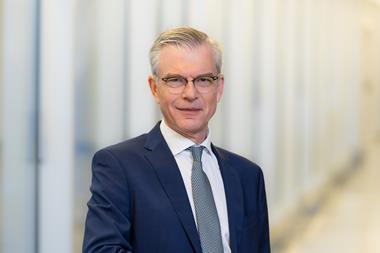The Polish asset management market is by far the largest in the region, a factor reflecting its population of 38m as well as an early start. The mutual fund industry celebrates its 15th birthday this year: Pioneer's Balanced Fund, the country's first, has grown to PLN5.5bn (€1.4bn), by far the biggest in the country.
Fund managers remain very positive about Poland's asset industry. "Wealth has been accumulating at a very strong pace," says Péter Heim, regional investment director at Aegon. "The economy is strong, leading to more savings, the system is stable and the number of high net worth individuals is booming, so you have a huge asset generating potential."
Poland's mutual funds rocketed by 64% year on year to PLN89bn (€23.4bn) at the end of October 2006. The biggest growth rate was in local equity funds, followed by mixed funds with varying proportions of equity, while investors sold Polish zloty, dollar and euro fixed income funds. Overall, mixed funds combining equity and bonds account for around 50% of the market, followed by Polish equity funds at 18%.
A combination of strong global and local stock market performance, accelerating economic growth and historically low Polish interest rates - which in 2006 fell below those of the US for the first time - have driven the growth in equity mutual funds.
"People forget about risk and have moved their money out of bond funds, and also out of other sources such as bank deposits, into equity funds," says Zbigniew Jagiello, CEO at Pioneer Pekao Investment Fund Company in Warsaw. Additionally, the funds themselves have performed
well. According to Jagiello, one of Pioneer's small to mid-cap equity funds has produced a return of 70% on the year. In 2006 Polish stocks outperformed
the European and US markets. The main WIG index rose 41% in the first 11 months of the year and despite a market correction in May Polish clients remained loyal, almost exclusively so, to the local equity market.
Jagiello remains positive on the Polish stock market, especially given the dominant presence of the Polish pension funds as institutional investors that are unlikely to redeem a significant portion of their holdings in a short space of time. Nevertheless, he says, he expects more volatility in 2007 and urges the need for risk diversification through fixed income. "We're advising customers to invest into mixed funds, although it's difficult to fight with greed," he observes.
Since EU accession in 2004 the Polish market has been open to funds distributed under an EU passport, and although some 300 such products are now available, compared with around 250 Polish registered funds, they account for only around 1% of total assets under management. According to Jagiello, they face two problems. Polish investors have a currency risk, especially with a strengthening zloty, and pay more complicated taxes on returns. At the same time, Polish mutual funds have become more sophisticated in their demands, leading to new suites of tailored products. Jagiello cites Pioneer's launch in 2006 of capital guarantee funds and an umbrella fund focusing on the Chinese, Japanese and Pacific markets as examples of such niche investments.
As in mutual funds, so Poland's second pillar pension system is by far the largest in the region, with assets totalling PLN113.3bn (€29.6bn) at the end of November, a rise of 27% on the year in zloty terms, while the number of subscribers rose to 12.3m from 11.7m.
The main change in asset allocation was an increase in equity exposure, to 35% from 32% a year earlier, which is moving close to the maximum limit for the funds. "This is due to the strong performance of the Warsaw Stock Exchange," explains Michal Szymanski, chief investment officer and member of the management board of Commercial Union Pension Fund. CU Poland's second pillar fund is the country's largest.
The Warsaw exchange is becoming a regional rather than a domestic market, notes Szymanski. Its new listings in 2006, 28 in the first 11 months of the year, included foreign companies such as Czech power generator CEZ, and the pension fund industry is widely credited for creating a virtuous circle in boosting liquidity and enabling large corporations to list in Warsaw.
At 62%, fixed income exposure was marginally down. Szymanski adds that there might be a change in fixed income investment this year with more corporate issues as economic growth accelerates. Currently companies still prefer to raise bank loans.
Despite years of lobbying by the fund management industry for a relaxation, the Polish market remains constricted by the 5% limit on foreign investment. The regulators are currently preoccupied with a merger to form a pan-financial supervisory authority: the Securities and Exchange Commission and Pensions and the Insurance and Pension Funds Supervisory Commission merged in 2006 to form the Financial Supervision Commission, with the Banking Supervisory Commission joining this year.
Other components of the Polish private pensions system have grown less spectacularly. The third pillar system, based largely on employer schemes, had around 970 programmes in place in November, and since Poland transposed the EU pensions directive it is now open to foreign employers. The third pillar offers limited tax advantages and the schemes are complicated to set up. Poland's unemployment rate, the highest in the EU, also gave employers little need to attract workers.
However, the picture is changing as the unemployment rate falls - it dropped to 14% in October from 17.2% a year earlier - due to economic growth picking up alongside massive emigration to richer
EU countries. "Staff retention is becoming an issue, leading to incentives for loyalty such as private pension schemes," adds Szymanski.
The so-called fourth pillar funds based in individual retirement accounts (IKEs) have also grown less spectacularly than expected when they were launched in 2004. IKEs are savings accounts available from banks, life insurance companies, investment funds and brokerages that offer capital gains tax exemptions if held to retirement.
Although the government predicted that up to 3.5m people would set up these accounts in the first year of their launch, at mid-2006 only 677,000 had done so, with more than 70% going for life insurance products, 18% for investment funds, 8% for bank products and the rest for brokerage house offerings.
Consultation has started on further revisions of pensions legislation. Szymanski notes that it would be helpful to the industry to have costs incurred on overseas investments deducted from a fund's assets rather than the P&L account of the pension fund management companies themselves. It remains to be seen whether the industry will follow moves by others in the region such as the Baltic States, Slovakia and most recently Hungary, and allow pension fund management companies to offer funds with different risk profiles for different age groups. Currently, one size fits all in Poland.












No comments yet